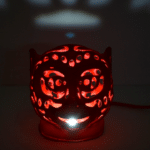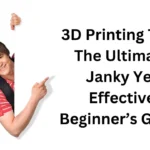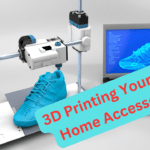
If you’ve ever considered diving into the world of 3D printing, you might be wondering about one crucial aspect: how long does it actually take to print something? This is a common concern for newcomers to the technology, and understandably so. The thought of waiting hours or even days for a project to finish can be daunting. However, the reality of 3D printing times is often more manageable than it seems.
Affiliate Disclosure
We participate in Amazon affiliate programs, earning fees from qualifying purchases via links at no extra cost to you. It’s how we keep this blog rolling and my 3D printers buzzing with fresh filament for reviews like this one!
Imagine you’ve designed a custom phone case or a unique piece of home decor. You hit “print” and then what? Do you sit around for hours twiddling your thumbs? Not necessarily! In this article, we’ll explore the factors that influence 3D printing times and provide some reassuring insights into the process.
How Long Does 3D Printing Take?
The time it takes for 3D printing depends on several factors, including size, complexity, material, and printer settings. Small, simple objects can print in minutes, while large, complex ones may take days. For example, a small figurine might take a few hours, while a large model car could take over 24 hours.
The Big Question: Why Does 3D Printing Take So Long?
It’s a valid question—and one that many first-timers ask. Whether you’re printing a small figurine or a functional tool, the process can seem surprisingly slow. But here’s the truth: the time 3D printing takes isn’t a drawback—it’s a feature. The precision and flexibility that 3D printing offers are unmatched by other manufacturing methods, and that takes a little extra time.
What Affects 3D Printing Time?
1. Object Size and Complexity
The larger and more intricate your design, the longer it will take to print. A simple cube might take just 30 minutes, but a detailed model with complex geometries could stretch into several hours—or even days. On average, most 3D prints take 2-12 hours. Small, simple items might be done in under an hour, while very large or complex prints can take over 24 hours.
Practical Tip: Before printing, use your slicer software to estimate the time required. Many programs, like Cura or PrusaSlicer, provide fairly accurate predictions.
2. Printer Settings and Resolution
The higher the resolution (or layer height), the longer the print. A fine resolution of 0.1mm creates stunningly smooth details but requires more layers than a coarser setting like 0.3mm. Lower resolutions print faster but with visible layering.
Practical Tip: Balance quality and speed by choosing a layer height that fits your project’s needs. For prototypes, lower resolutions work well. For display pieces, go for finer settings.
3. Layer Height
Layer height is a critical parameter in 3D printing that directly influences both the print quality and speed. It refers to the thickness of each layer of material that the printer deposits during the printing process.
Practical Tip: Finding the right balance between layer height and print speed is essential. For example, using a layer height of 0.2 mm typically offers a good compromise between speed and quality for many common materials like PLA.
4. Material Used
The choice of material in 3D printing is paramount as different materials possess unique properties that can affect both print speed and quality.
Practical Tip: Choose materials based on the intended application of the printed object. For instance, if flexibility is needed, TPU is preferable despite its slower printing requirements.
Why 3D Printing Isn’t a “Set It and Forget It” Process
It’s easy to think of 3D printing as a one-click solution, but the process involves careful preparation:
- Calibration: Ensuring your printer is properly calibrated can take time but saves headaches down the line.
- Material Type: Some materials, like PLA, print faster than others, like ABS or flexible TPU.
- Post-Processing: Many prints require cleaning, sanding, or painting after they’re done, which adds to the total time investment.
Practical Tip: If you’re printing for a deadline, factor in preparation and post-processing when planning your project.
Addressing Common Misconceptions
“Why can’t 3D printers work faster?”
While speed is improving with advancements in technology, faster prints often mean sacrificing quality or strength. Think of it like baking: rushing the process might save time, but you could end up with an undercooked result.
Empathy Moment: If you’ve ever felt impatient watching a print slowly take shape, you’re not alone! It’s part of the journey—and the anticipation makes the final result even more satisfying.
Which Items Take the Longest to Print?
- Large-Scale Models: Architectural designs or large figurines often require days to complete.
- High-Detail Parts: Intricate models like jewelry or fine art pieces require slow, fine resolution.
- Functional Prototypes: Items needing high infill for strength, like tools or mechanical parts, also take more time.
How to Speed Up Your 3D Printing Projects
If time is of the essence, here are some ways to optimize your 3D printing workflow:
- Reduce Infill Percentage: Lowering infill can significantly cut down printing time while still maintaining strength for non-load-bearing parts.
- Print Multiple Items Simultaneously: If your printer’s build plate is large enough, batch similar items to save time overall.
- Upgrade Your Printer: High-speed printers like those using CoreXY designs or resin printing technology can produce faster results without compromising quality.
Practical Tips for Managing Print Times
If you’re eager to get started with your 3D printing projects, here are some practical tips to help manage your expectations regarding print times:
- Plan Ahead: If you have a deadline for your project, factor in additional time for printing and potential troubleshooting.
- Use Pre-Designed Models: Consider using pre-designed models from platforms like Thingiverse or MyMiniFactory. These models often come with optimized settings that can save time.
- Optimize Settings: Experiment with different layer heights and speeds in your slicer software to find a balance between quality and speed that works for your project.
- Keep Your Printer Maintained: Regular maintenance can help ensure your printer runs efficiently, potentially reducing downtime during prints.
- Test Prints: For complex designs, consider doing test prints at smaller sizes or lower resolutions before committing to full-scale prints.
Average Time Estimates for Different Items
Let’s break down the average time it takes to print various common items using different types of printers.
Small Objects
For small objects like keychains or simple figurines, the average print time is relatively quick:
- FDM Printers: A small object typically takes about 30 minutes to 2 hours.
- SLA Printers: Small items may take around 1-4 hours depending on detail.
- DLP Printers: Similar to SLA, expect around 1-3 hours for small prints.
Sized Objects
For medium-sized objects like vases or larger figurines:
- FDM Printers: Expect around 2-6 hours based on complexity.
- SLA Printers: Medium-sized prints usually take about 4-8 hours.
- SLS Printers: These can take anywhere from 4-10 hours depending on design intricacies.
Large Objects
For large items such as furniture parts or detailed sculptures:
- FDM Printers: These can take anywhere from 6 hours up to several days (20+ hours).
- SLA Printers: Large prints may take anywhere from 8 hours to over a day.
- SLS Printers: Depending on size and complexity, expect anywhere from 10 hours up to several days (200+ hours).
| Item Size | Printer Type | Average Print Time |
|---|---|---|
| Small Objects | FDM Printers | 30 minutes to 2 hours |
| SLA Printers | 1 to 4 hours (depending on detail) | |
| DLP Printers | 1 to 3 hours | |
| Medium-Sized Objects | FDM Printers | 2 to 6 hours (based on complexity) |
| SLA Printers | 4 to 8 hours | |
| SLS Printers | 4 to 10 hours (depending on design) | |
| Large Objects | FDM Printers | 6 hours to several days (20+ hours) |
| SLA Printers | 8 hours to over a day | |
| SLS Printers | 10 hours to several days (200+ hours) |
FAQs on 3D Printing Time
How long does a simple print take?
A small, basic object, like a keychain, can take 30 minutes to 2 hours.
What’s the longest a print might take?
Large or highly detailed prints can take 24 to 72 hours, depending on complexity.
How do printer settings affect time?
Higher resolutions with smaller layer heights take longer but produce better detail. Lower resolutions are faster but less precise.
Do different materials affect printing time?
Yes. PLA generally prints faster, while flexible or high-temperature materials like TPU and ABS take more time.
Can I stop a print and resume later?
Most modern 3D printers have this capability, but it’s essential to test your printer’s pause-and-resume function first.
A Final Thought: Patience Pays Off
While waiting for your print might test your patience, it’s essential to remember why the process takes time. The layer-by-layer construction ensures precision, durability, and customization that no other manufacturing method can match.
If you’re new to 3D printing, don’t hesitate to reach out to experienced makers or forums for advice tailored to your specific project. And most importantly, enjoy the process—it’s just as rewarding as the final product!













